2012 RENAULT WIND ROADSTER ECU
[x] Cancel search: ECUPage 30 of 185

child restraint/seat ................................ (up to the end of the DU)
child restraint/seat ................................ (up to the end of the DU)
child restraint/seat ................................ (up to the end of the DU)
child safety ............................................ (up to the end of the DU)
child seats ............................................. (up to the end of the DU)
transporting children ............................. (up to the end of the DU)
1.24
ENG_UD20474_3
Sécurité enfants : installation du siège enfant (E33 - X33 - Renault)
ENG_NU_865-6_E33_Renault_1
Jaune NoirNoir texte
Some seats are not suitable for fitting
child seats. The diagram on the follow -
ing page shows you how to attach a
child seat.
The types of child seats indicated may
not be available. Before using a differ-
ent child seat, check with the manufac-
turer that it can be fitted.
fitting a child seat
CHILD SAFETY : fitting a child seat (1/3)
In the front seat
The laws concerning children travel -
ling in the front passenger seat differ in
every country. Consult the legislation in
force and follow the indications on the
diagram on the following page.
Before fitting a child seat in this seat (if
authorised):
– move the seat as far back as pos-
sible;
– on equipped vehicles, raise the
seat base as far as possible;
– gently tilt the seatback away from
vertical (approximately 25°).
Do not change these settings after the
child seat is installed.
Check that when installing
the child seat in the vehi -
cle it is not at risk of coming
loose from its base.
If you have to remove the headrest,
check that it is correctly stored so
that it does not come loose under
harsh braking or impact.
Always attach the child seat to the
vehicle even if it is not in use so that
it does not come loose under harsh
braking or impact.
RISK OF DEATH OR SERIOUS INJURY: before fitting a rear-facing child
seat in this position, check that the air bag has been deactivated (refer to
the information on “Child safety: deactivating/activating the front passen-
ger air bag” in Section 1).
Children of a maximum height of 135 cm are permitted to occupy the front seat if
the air bag is deactivated and a suitable restraint system is used. For passengers
above this height, the air bag must remain active.
Page 31 of 185
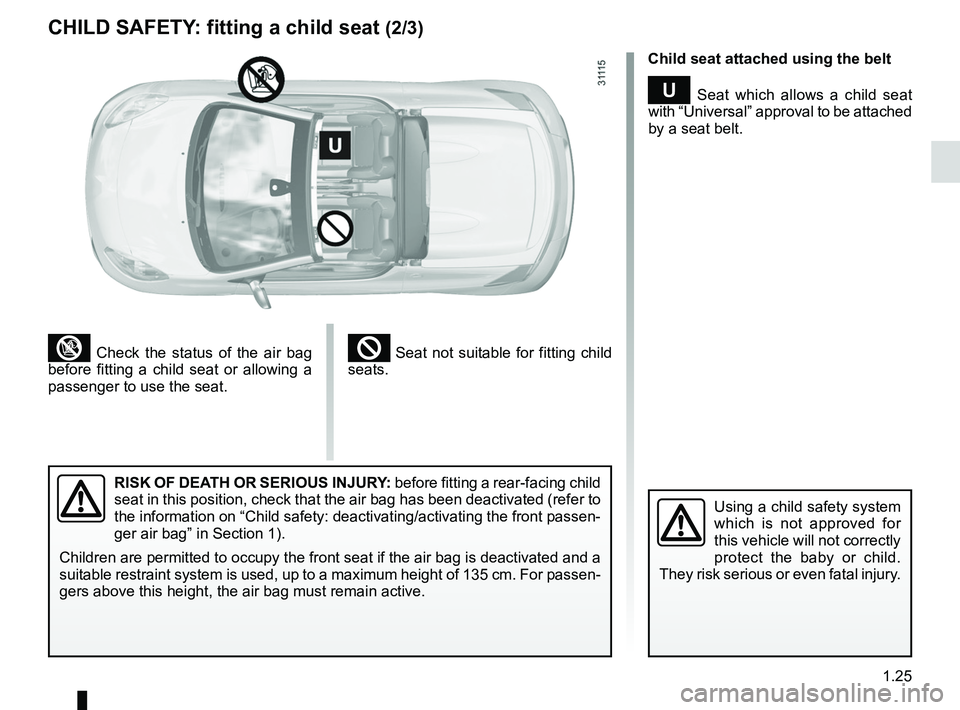
JauneNoirNoir texte
1.25
ENG_UD20474_3
Sécurité enfants : installation du siège enfant (E33 - X33 - Renault)
ENG_NU_865-6_E33_Renault_1
² Seat not suitable for fitting child
seats.³ Check the status of the air bag
before fitting a child seat or allowing a
passenger to use the seat.
Using a child safety system
which is not approved for
this vehicle will not correctly
protect the baby or child.
They risk serious or even fatal injury.
CHILD SAFETY : fitting a child seat (2/3)
Child seat attached using the belt
¬ Seat which allows a child seat
with “Universal” approval to be attached
by a seat belt.
RISK OF DEATH OR SERIOUS INJURY: before fitting a rear-facing child
seat in this position, check that the air bag has been deactivated (refer to
the information on “Child safety: deactivating/activating the front passen-
ger air bag” in Section 1).
Children are permitted to occupy the front seat if the air bag is deactivated and a
suitable restraint system is used, up to a maximum height of 135 cm. For passen -
gers above this height, the air bag must remain active.
Page 32 of 185
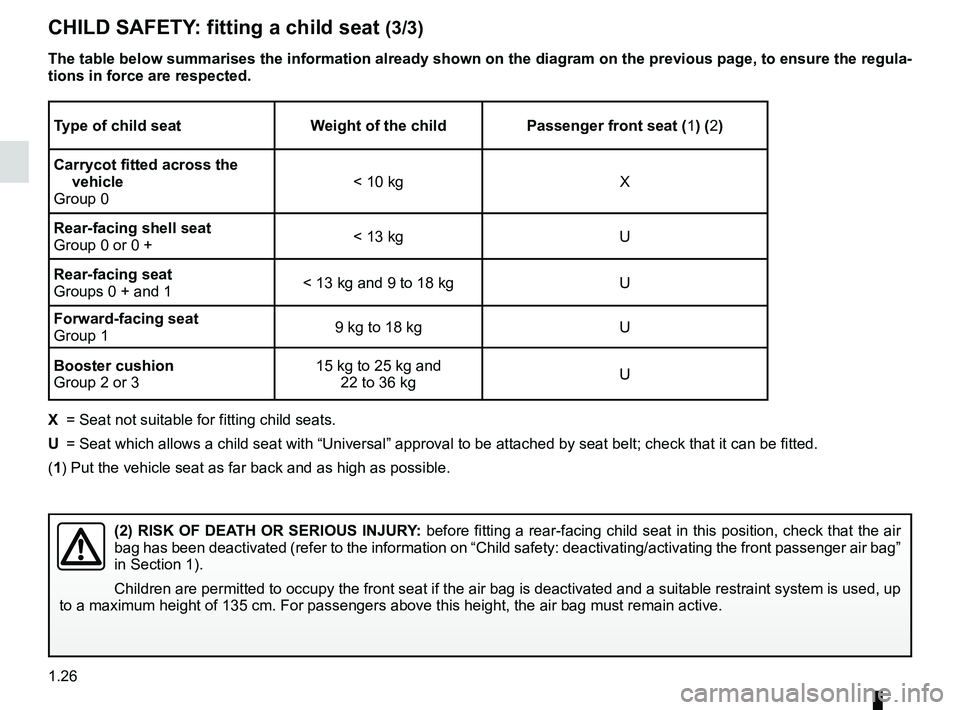
1.26
ENG_UD20474_3
Sécurité enfants : installation du siège enfant (E33 - X33 - Renault)
ENG_NU_865-6_E33_Renault_1
CHILD SAFETY : fitting a child seat (3/3)
Type of child seat Weight of the childpassenger front seat (1) (2)
Carrycot fitted across the vehicle
Group 0 < 10 kg
X
Rear-facing shell seat
Group 0 or 0 + < 13 kg
U
Rear-facing seat
Groups 0 + and 1 < 13 kg and 9 to 18 kg
U
Forward-facing seat
Group 1 9 kg to 18 kg
U
Booster cushion
Group 2 or 3 15 kg to 25 kg and
22 to 36 kg U
X = Seat not suitable for fitting child seats.
U = Seat which allows a child seat with “Universal” approval to be attached by seat belt; check that it can be fitted.
(1) Put the vehicle seat as far back and as high as possible.
(2) RISK OF DEATH OR SERIOUS INJURY: before fitting a rear-facing child seat in this position, check that the air
bag has been deactivated (refer to the information on “Child safety: deactivating/activating the front passenger air bag”
in Section 1).
Children are permitted to occupy the front seat if the air bag is deactivated and a suitable restraint system is used, up
to a maximum height of 135 cm. For passengers above this height, the air bag must remain active.
The table below summarises the information already shown on the diagram on the previous page, to ensure the regula-
tions in force are respected.
Page 33 of 185

1.27
ENG_UD21752_3
Sécurité enfants : désactivation/activation airbag passager avant (E33 - X33 - Renault)
ENG_NU_865-6_E33_Renault_1
deactivating/activating the front passenger air bag
The passenger air bag must
be activated or deactivated
with the ignition off .
If it is interfered with when
the vehicle is being driven, indicator
lights
å and © will come
on.
Switch the ignition off then on again
to reset the air bag in accordance
with the lock.
CHILD SAFETY : deactivating/activating the front passenger air bag (1/3)
Deactivating the front
passenger airbags
(on equipped vehicles)
In order to fit a child seat to the front
passenger seat when this is allowed,
you must deactivate the front passen-
ger seat additional restraint devices
(side airbags and, depending on vehi -
cle, front airbags, etc.).
2
To deactivate the air bags: with the
vehicle stationary , push and turn
lock 1 to the OFF position.
With the ignition on, it is essential to
check that warning light 2
¹ is lit
on the central display and, depend -
ing on the vehicle, that the message
“ PASSENGERAIRBAG OFF ” is dis-
played.
This light remains permanently lit to
let you know that you can fit a child
seat.
1
DANGER
Since operation of the front
passenger air bag is not
compatible with the position
of a rear-facing child seat, NEVER
fit a rear-facing child seat on a front
passenger seat with an active front
air bag. The child may suffer very
serious injuries if the air bag is trig-
gered.
Page 34 of 185
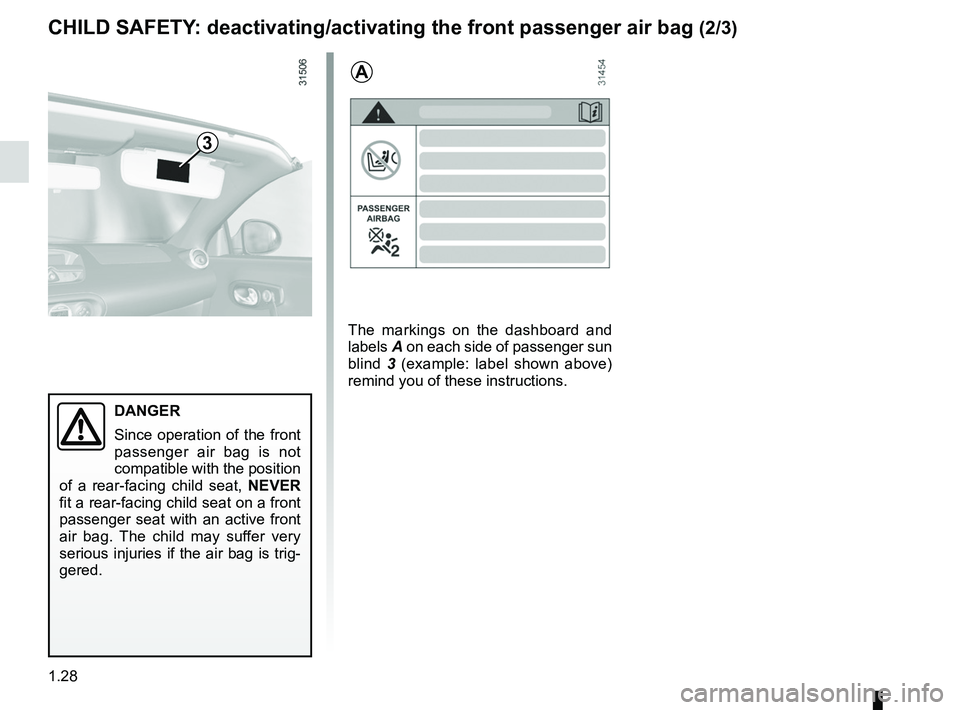
1.28
ENG_UD21752_3
Sécurité enfants : désactivation/activation airbag passager avant (E33 - X33 - Renault)
ENG_NU_865-6_E33_Renault_1
Jaune NoirNoir texte
CHILD SAFETY : deactivating/activating the front passenger air bag (2/3)
DANGER
Since operation of the front
passenger air bag is not
compatible with the position
of a rear-facing child seat, NEVER
fit a rear-facing child seat on a front
passenger seat with an active front
air bag. The child may suffer very
serious injuries if the air bag is trig-
gered.
The markings on the dashboard and
labels A on each side of passenger sun
blind 3 (example: label shown above)
remind you of these instructions.
A
3
Page 35 of 185
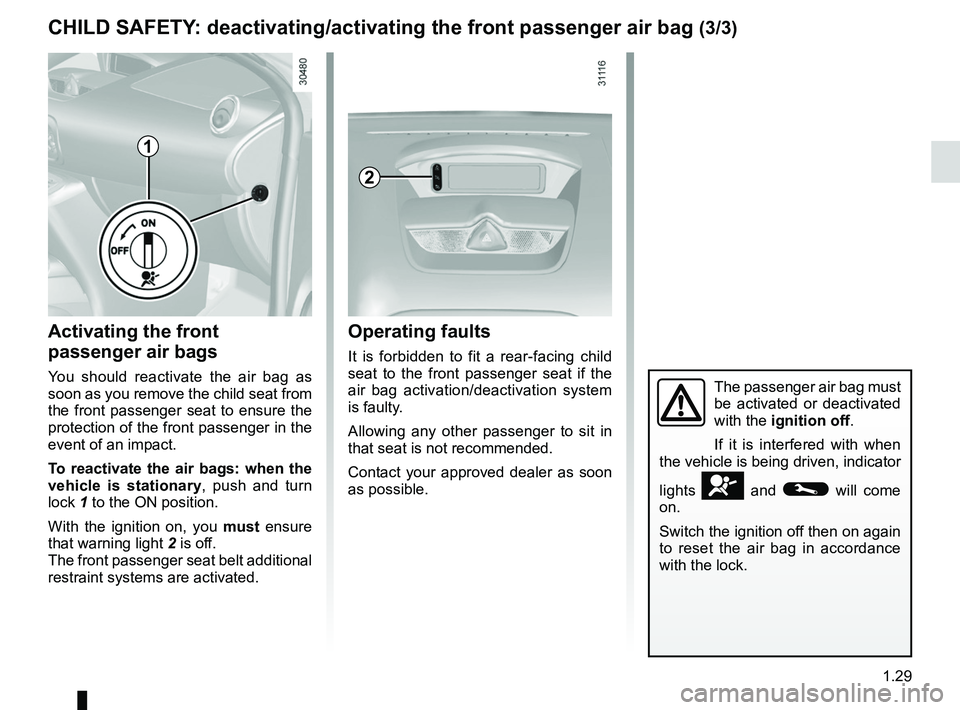
JauneNoirNoir texte
1.29
ENG_UD21752_3
Sécurité enfants : désactivation/activation airbag passager avant (E33 - X33 - Renault)
ENG_NU_865-6_E33_Renault_1
CHILD SAFETY : deactivating/activating the front passenger air bag (3/3)
The passenger air bag must
be activated or deactivated
with the ignition off.
If it is interfered with when
the vehicle is being driven, indicator
lights
å and © will come
on.
Switch the ignition off then on again
to reset the air bag in accordance
with the lock.
Operating faults
It is forbidden to fit a rear-facing child
seat to the front passenger seat if the
air bag activation/deactivation system
is faulty.
Allowing any other passenger to sit in
that seat is not recommended.
Contact your approved dealer as soon
as possible.
Activating the front
passenger air bags
You should reactivate the air bag as
soon as you remove the child seat from
the front passenger seat to ensure the
protection of the front passenger in the
event of an impact.
To reactivate the air bags: when the
vehicle is stationary , push and turn
lock 1 to the ON position.
With the ignition on, you must ensure
that warning light 2 is off.
The front passenger seat belt additional
restraint systems are activated.
2
1
Page 58 of 185
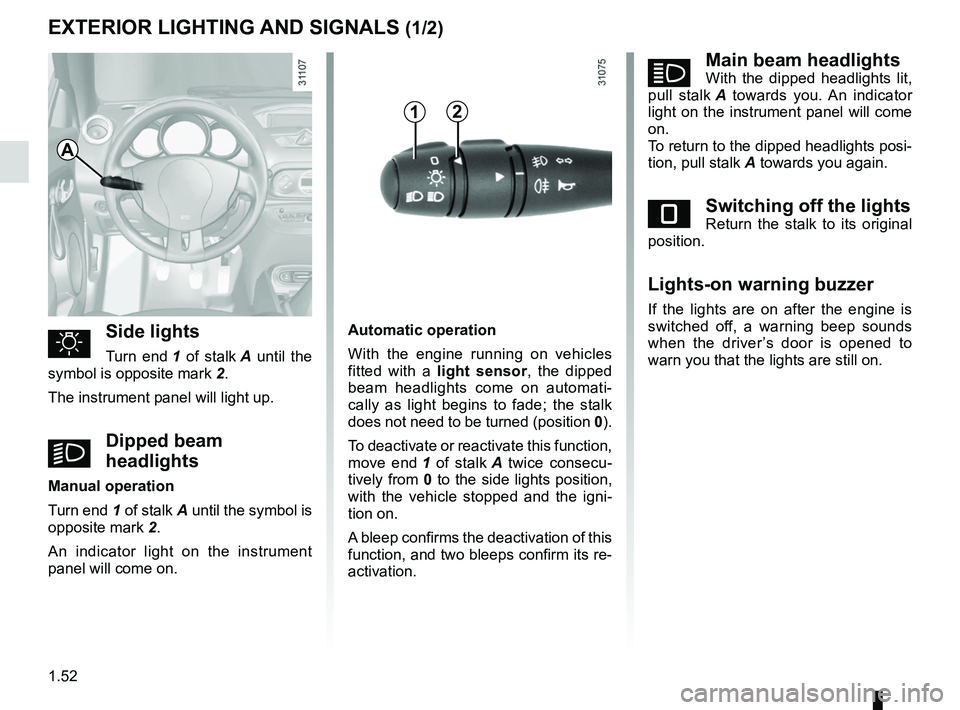
lighting:exterior ............................................ (up to the end of the DU)
instrument panel .................................................... (current page)
lights: side lights ......................................................... (current page)
lights: dipped beam headlights ................................... (current page)
hazard warning lights signal .................................. (current page)
signals and lights .................................. (up to the end of the DU)
lighting: instrument panel .............................................. (current page)
daytime running lights ............................................ (current page)
1.52
ENG_UD21753_2
Éclairages et signalisations extérieurs (E33 - X33 - Renault)
ENG_NU_865-6_E33_Renault_1
Jaune NoirNoir texte
áMain beam headlightsWith the dipped headlights lit,
pull stalk A towards you. An indicator
light on the instrument panel will come
on.
To return to the dipped headlights posi-
tion, pull stalk A towards you again.
eSwitching off the lightsReturn the stalk to its original
position.
Lights-on warning buzzer
If the lights are on after the engine is
switched off, a warning beep sounds
when the driver ’s door is opened to
warn you that the lights are still on.
Exterior lighting and signals
EXTERIOR LIGHTING AND SIGNALS (1/2)
uSide lights
Turn end 1 of stalk A until the
symbol is opposite mark 2.
The instrument panel will light up.
kDipped beam
headlights
Manual operation
Turn end 1 of stalk A until the symbol is
opposite mark 2.
An indicator light on the instrument
panel will come on.
A
Automatic operation
With the engine running on vehicles
fitted with a light sensor , the dipped
beam headlights come on automati -
cally as light begins to fade; the stalk
does not need to be turned (position 0).
To deactivate or reactivate this function,
move end 1 of stalk A twice consecu -
tively from 0 to the side lights position,
with the vehicle stopped and the igni -
tion on.
A bleep confirms the deactivation of this
function, and two bleeps confirm its re-
activation.
21
Page 109 of 185

transporting objectsin the luggage compartment ........... (up to the end of the DU)
towing rings .......................................... (up to the end of the DU)
towing towing equipment ............................ (up to the end of the DU)
towing equipment fitting ............................................... (up to the end of the DU)
towing a caravan .................................. (up to the end of the DU)
3.25
ENG_UD22203_3
Transport d’objets dans le coffre (E33 - X33 - Renault)
ENG_NU_865-6_E33_Renault_3
Transporting objects in the luggage compartment
tRansPoRting oBjeCts in tHe luggage CoMP aRtMent
Always position the heavi-
est items directly on the
floor. Use the lashing points
on the luggage compart -
ment floor, if these are fitted to the
vehicle. The luggage should be
loaded in such a way that no items
will be thrown forward and strike the
occupants if the driver has to brake
suddenly.
Always position the objects transported
so that the largest surface is against the
partition.anchorage points
Hooks 2 located on either side of the
luggage compartment allow the load to
be secured.
2
1
Reinforcement bars 1 must
not be removed.
t ransporting objects on the
roof and on the roof cover
The fitting of roof bars is prohibited on
this vehicle.